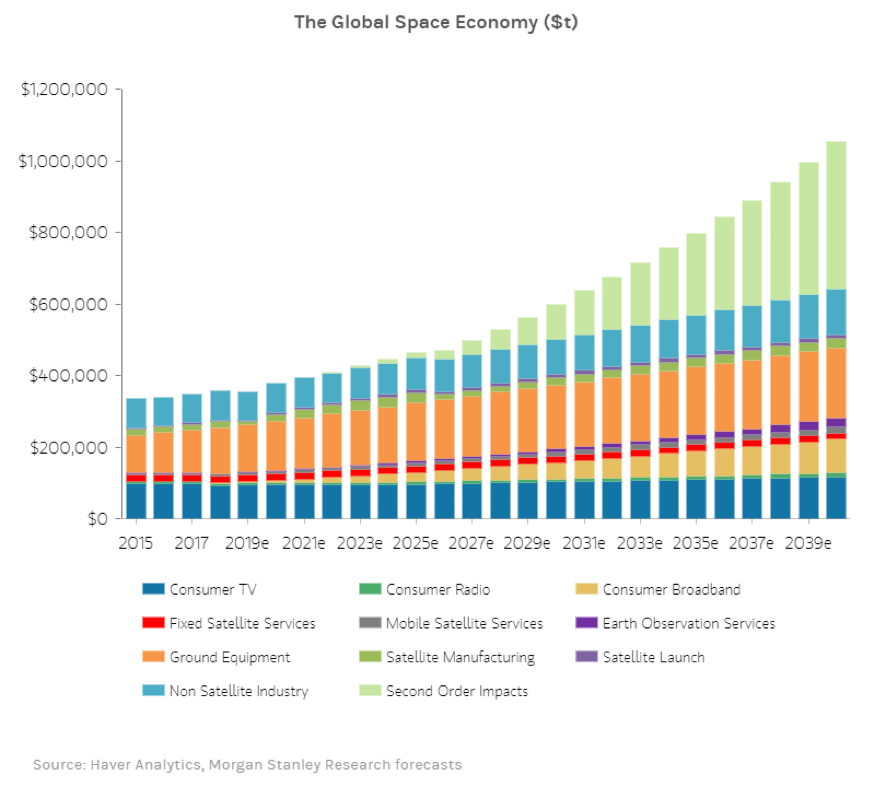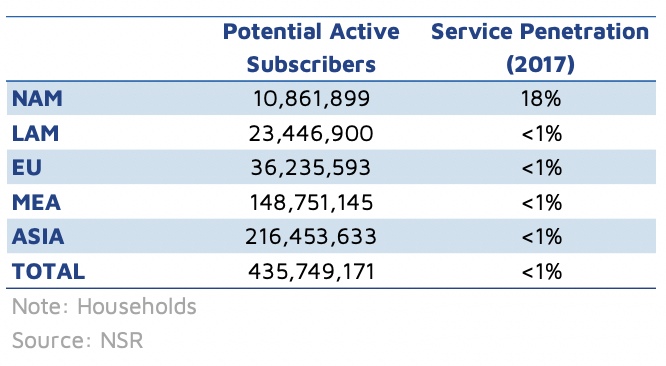|
Will LEOs Create a
Trillion-Dollar Industry?
August 28, 2019 by Lluc Palerm-Serra | NSR
The Space industry is progressively attracting more
interest from the investment community. In fact,
investment banks including Morgan Stanley, Goldman Sachs
and Bank of America Merrill Lynch expect the Space
industry to grow to over $1 trillion by 2040.
Expectations from private investors are not far behind,
Jeff Bezos justified the investment in the Kuiper
constellation based on the potential for it to “move the
needle” for Amazon, a company generating annual revenues
of $233 billion USD.
Is the addressable market big enough to support these
projections?

The satellite communications industry and its derived
applications (DTH, Consumer Broadband, Backhaul,
Mobility, etc.) has historically been a big portion of
Space revenues and would need to contribute to future
growth to reach those market potentials. According to
NSR’s
Global Satellite Capacity Supply and Demand, 16th
Edition report,
Satcom wholesale capacity revenues will reach $24.7
Billion by 2028. Assuming the same 6.8% CAGR as in the
2018-2028 period, the industry would generate $54.5
Billion annually by 2040. Even adding in
elements such as satellite manufacturing, launch and
ground equipment, the total is a good distance from the
$1 trillion projection. Given this, are there any
hidden use case that could boost the industry to a
trillion-dollar Space economy?
The Expectations from the Investment Community
As per Morgan Stanley, the main source for growth for
the Space industry, apart from Second Order Impacts,
will be Broadband. The investment bank expects the
vertical to become a $95 billion market by 2040, growing
from somewhere in the neighborhood of $2 billion today.
While NSR agrees on the fact that many Satellite
Broadband use cases are still underpenetrated today,
stimulating demand has not been easy and sustaining high
growth rates over decades could exhaust the addressable
market.

Connecting the Other Half. Really?
“Connecting the other half of the population”
referencing to the fact that
50% of the population remains unconnected is a
recurrent motto within the satellite industry. However,
NSR believes the addressable market is significantly
smaller. The
Broadband coverage gap “only” represented 10% of the
world population according to GSMA. When one also
weights in other factors such as available income or
digital skills, the potential market for Satcom can be
defined realistically.

Based on estimates developed on NSR’s
VBSM17 report,
the addressable market for Satellite Consumer Broadband
accounts for 435M households. Service
penetration outside North America is still at minimal
levels, and NSR projects solid growth coming from this
vertical. However, one must bear in mind that revenues
per user extracted in emerging markets will be
significantly smaller than the $84.26 ARPU that ViaSat
realizes in the U.S., and NSR estimates a global average
ARPU (considering users connecting through Wi-Fi
aggregation points) in the neighborhood of ~20 USD by
2028. This yields a
total market potential of $104 billion. This is
the theoretical roof of the market, but NSR considers
the realistic opportunity to be smaller than that given
existing challenges such as the “usage gap”, the
difficulties in creating distribution channels or
competition from alternative technologies.
It Is Not (Only) About the Bandwidth
No one can deny how impactful digital inclusion is to
enhance the economy and wellbeing, from better education
and healthcare to more efficient companies and greater
market opportunities. An important concept is sometimes
referred to as “digital spillover”, when technology
accelerates knowledge transfer, business innovation, and
performance to achieve a sustainable development and
economic impact. Huawei estimated the digital spillover
to have an impact on the GDP x2.5 times larger than the
actual investment in digital assets. In fact, Morgan
Stanley estimates that over $400 billion from their $1
trillion Space-economy from 2040 will come from “Second
Order Impacts”.
NSR acknowledges that there are multiple use cases that
could be enabled by Satellite connectivity. For example,
as observed in
BDAvS3 report, satellite big data could generate
$17.7 billion in 10-year cumulative revenues by 2028.
Consequently,
it won’t come as a big surprise that the big supporters
of LEO constellations are at the same time strongly
positioned to capture opportunities in these “Second
Order Impacts”. From connecting Self-driving
cars, delivering truly ubiquitous cloud services or
enhancing communications cybersecurity, actors like
Softbank, Google or Amazon could greatly benefit from
seeing LEO constellations become operational. Some
established actors are anticipating this transition and
trying to capture a portion of these additional
revenues, for example SES forging a collaboration with
IBM Cloud.
Bottom Line
From a thriving startup ecosystem to ultra-rich
individuals investing in the industry or investment
bankers valuing the Space economy in trillions of
dollars, Space is increasingly enticing for investors.
However,
one must not be carried away by Silicon Valley dreamers
and do a balanced analysis of the market opportunity.
Markets like Consumer Broadband have created enormous
expectations but, while it is true that the addressable
market is massive and the opportunity is still largely
untapped, stimulating demand presents its own challenges
and NSR is more cautious projecting the growth of the
vertical estimating revenues in $17.3 Billion by 2027,
or what is the same, 16.6% market penetration over Total
Addressable Market.
While raw bandwidth is being commoditized, our increased
dependence on digital technologies is opening (in
parallel) sizable opportunities for value added
services. In fact, the
big investors behind LEO constellations are very well
positioned to benefit from these second order impacts of
ubiquitous connectivity.
Subscribe to talksatellite weekly newsletter -
circ@talksatellite.com
|